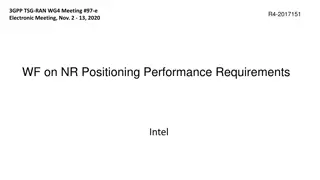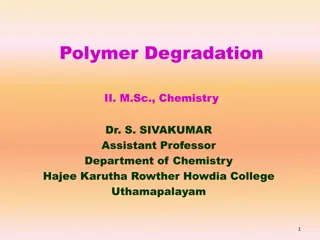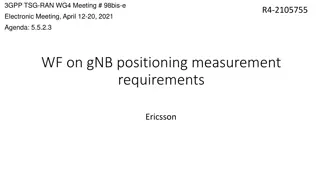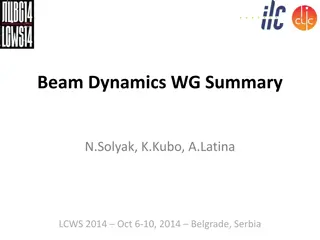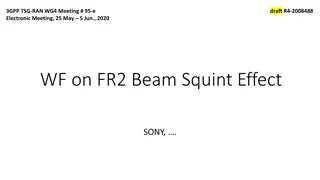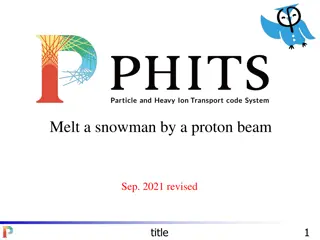Simulation Assumptions and Performance Degradation Study on Beam Squint in 3GPP Meeting
Background on beam squint in conducted power of transmitted CCs causing radiative domain impairment and gain droop, with a problem statement on degradation of CC2 spherical coverage when CC1 and CC2 are separated by frequency. The study involves refined simulation assumptions to quantify radiative degradation due to beam squint, focusing on antenna parameters, transmission line impairments, and EIRP spherical coverage. Simulation scenarios are defined for quantifying degradation as a function of CC frequency separation.
Download Presentation

Please find below an Image/Link to download the presentation.
The content on the website is provided AS IS for your information and personal use only. It may not be sold, licensed, or shared on other websites without obtaining consent from the author. Download presentation by click this link. If you encounter any issues during the download, it is possible that the publisher has removed the file from their server.
E N D
Presentation Transcript
3GPP TSG-RAN WG4 Meeting # 94-e-Bis Electronic Meeting, 20 30 Apr., 2020 R4-2005675 WF on simulation assumptions for beam squint study SONY
Background Conducted power in transmitted CCs Beam squint happens when DL BM reference signals and UL/DL control and/or data channels of interest are not within the same CC, see figure on right Beam squint causes a received signal to have a frequency selective characteristic It is a radiative-domain impairment It causes gain droop, like impairment caused by active circuitry in the conducted domain Problem statement: Given CC1 and CC2 separated by f and assuming the UE uses the codebook entry optimized for CC1, what is the degradation of CC2 spherical coverage? The WF includes the refined simulation assumptions for further align the quantified results of radiative degradation due to the beam squint when common beam management is adopted for CC1 and CC2. Blue CC squints away from target direction due to separation in frequency from reference signal gNB Ref signal for BM Power received OTA x dB Difference in antenna gain, x dB UE 2
Simulation assumptions To derive and align the performance degradation due to the beam squint in next meeting, the following simulation assumptions for antennas are encouraged to be used: Parameter* Value Notes Companies are recommended to align the antenna array size according to TR-38.817 implementation choice Antenna array size implementation specific Element spacing Antenna Element pattern Antenna element choice is up to implementation See TR38.803/Patch/Dipole Reuse gain variation and phase variation models from the Rel-15 beam correspondence study, frequency drift of phase shifter also be taken into account Phase shifter impairments See TR38.817-01 Transmission line impairments Modeled TL length and loss per element Transmission line lengths per antenna element, mismatch, and loss *Note: parameters which haven been taken into account for spherical coverage and multi band relaxation shall not be double counted. 3
Simulation on the degradation of EIRP spherical coverage due to beam squint EIRP spherical coverage: EIRP in CA is measured as the total power received over all CCs. Two CCs are assumed in the simulation (CC1 and CC2): 1. The codebook is optimized for CC1 while estimating the spherical coverage based on the total power of CC1 and CC2 (EIRP_total (theta, phi) = EIRP_CC1(theta, phi)+EIRP_CC2(theta, phi)) spherical coverage 1 2. The codebook is optimized for CC1 and CC2, respectively, while estimating the spherical coverage based on the total power of CC1 and CC2 (EIRP_total (theta, phi) = EIRP_CC1(theta, phi)+EIRP_CC2(theta, phi)) spherical coverage 2 3. The degradation of the spherical coverage based on the total power on CC1 and CC2 shall be quantified degradation = spherical coverage 2-spherical coverage 1 The degradation needs to be presented as a function of frequency separation between CC2 and CC1. The frequency separation between two CCs: 0 MHz to 5200 MHz (both CCs are below 30 GHz), 0MHz to 6400MHz (both CCs are above 37 GHz) 4
Simulation on the degradation of EIS spherical coverage due to beam squint EIS spherical coverage: Sensitivity in CA is measured per CC Two CCs are assumed in the simulation (CC1 and CC2): 1. The codebook is optimized for CC1 while estimating the spherical coverage for CC2 spherical coverage 1 2. The codebook is optimized for CC2 while estimating the spherical coverage for CC2 spherical coverage 2 3. The degradation of the spherical coverage for CC2 shall be quantified degradation = spherical coverage 2-spherical coverage 1 The degradation needs to be presented as a function of frequency separation between CC2 and CC1. The frequency separation between two CCs: 0 MHz to 5200 MHz (both CCs are below 30 GHz), 0MHz to 6400MHz (both CCs are above 37 GHz) 5
WF The companies are encouraged to provide results on the EIRP and EIS degradation based on the simulation assumptions in the next meeting. The impact on other RF requirements, e.g., transmit power control tolerance and TPC loop convergence, are also recommended to be studied. 6
Reference R4-2004872 Beam squint analysis for FR2 UEs Qualcomm Incorporated R4-2004755 on beam squint cased degradation Huawei, HiSilicon R4-2003349 Preliminary analysis on beam squint due to larger frequency separation Sony, Ericsson R4-2004714 Views on radiative degradation mechanisms for larger frequency separation Apple Inc. R4-2005105 Email discussion summary for [94e Bis][19] NR_RF_FR2_req_enh_Part_3 Moderator (Qualcomm Incorporated) 7



